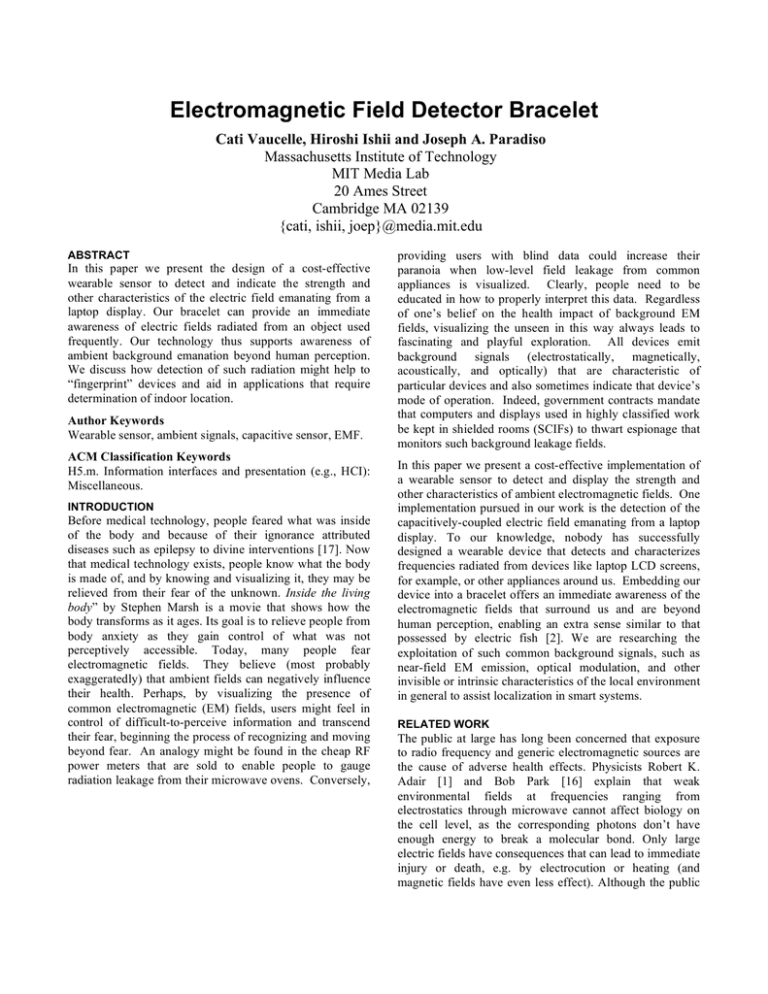Electromagnetic Field Detector Bracelet - tmg-trackr
advertisement

Electromagnetic Field Detector Bracelet
Cati Vaucelle, Hiroshi Ishii and Joseph A. Paradiso
Massachusetts Institute of Technology
MIT Media Lab
20 Ames Street
Cambridge MA 02139
{cati, ishii, joep}@media.mit.edu
ABSTRACT
In this paper we present the design of a cost-effective
wearable sensor to detect and indicate the strength and
other characteristics of the electric field emanating from a
laptop display. Our bracelet can provide an immediate
awareness of electric fields radiated from an object used
frequently. Our technology thus supports awareness of
ambient background emanation beyond human perception.
We discuss how detection of such radiation might help to
“fingerprint” devices and aid in applications that require
determination of indoor location.
Author Keywords
Wearable sensor, ambient signals, capacitive sensor, EMF.
ACM Classification Keywords
H5.m. Information interfaces and presentation (e.g., HCI):
Miscellaneous.
INTRODUCTION
Before medical technology, people feared what was inside
of the body and because of their ignorance attributed
diseases such as epilepsy to divine interventions [17]. Now
that medical technology exists, people know what the body
is made of, and by knowing and visualizing it, they may be
relieved from their fear of the unknown. Inside the living
body” by Stephen Marsh is a movie that shows how the
body transforms as it ages. Its goal is to relieve people from
body anxiety as they gain control of what was not
perceptively accessible. Today, many people fear
electromagnetic fields. They believe (most probably
exaggeratedly) that ambient fields can negatively influence
their health. Perhaps, by visualizing the presence of
common electromagnetic (EM) fields, users might feel in
control of difficult-to-perceive information and transcend
their fear, beginning the process of recognizing and moving
beyond fear. An analogy might be found in the cheap RF
power meters that are sold to enable people to gauge
radiation leakage from their microwave ovens. Conversely,
providing users with blind data could increase their
paranoia when low-level field leakage from common
appliances is visualized. Clearly, people need to be
educated in how to properly interpret this data. Regardless
of one’s belief on the health impact of background EM
fields, visualizing the unseen in this way always leads to
fascinating and playful exploration. All devices emit
background signals (electrostatically, magnetically,
acoustically, and optically) that are characteristic of
particular devices and also sometimes indicate that device’s
mode of operation. Indeed, government contracts mandate
that computers and displays used in highly classified work
be kept in shielded rooms (SCIFs) to thwart espionage that
monitors such background leakage fields.
In this paper we present a cost-effective implementation of
a wearable sensor to detect and display the strength and
other characteristics of ambient electromagnetic fields. One
implementation pursued in our work is the detection of the
capacitively-coupled electric field emanating from a laptop
display. To our knowledge, nobody has successfully
designed a wearable device that detects and characterizes
frequencies radiated from devices like laptop LCD screens,
for example, or other appliances around us. Embedding our
device into a bracelet offers an immediate awareness of the
electromagnetic fields that surround us and are beyond
human perception, enabling an extra sense similar to that
possessed by electric fish [2]. We are researching the
exploitation of such common background signals, such as
near-field EM emission, optical modulation, and other
invisible or intrinsic characteristics of the local environment
in general to assist localization in smart systems.
RELATED WORK
The public at large has long been concerned that exposure
to radio frequency and generic electromagnetic sources are
the cause of adverse health effects. Physicists Robert K.
Adair [1] and Bob Park [16] explain that weak
environmental fields at frequencies ranging from
electrostatics through microwave cannot affect biology on
the cell level, as the corresponding photons don’t have
enough energy to break a molecular bond. Only large
electric fields have consequences that can lead to immediate
injury or death, e.g. by electrocution or heating (and
magnetic fields have even less effect). Although the public
has been made aware of many medical studies indicating
negative effects of electric fields, e.g., reports indicating an
increase in leukemia for children living near power lines [5]
and studies reporting an increased risk for brain tumors
from the use of cell phones [11], the most careful studies
have found no significant results to support a causal role for
electromagnetic fields in causing cancer [12,16].
Nonetheless, some segments of society still consider the
results of epidemiological studies on mobile phones,
transmission towers, power lines, and other sources of EMI
to be inconclusive. Accordingly, manufacturers of
telephone handsets and commercial electronics, for
example, remain interested in measuring the long-term
integrated dose that is received from exposure to low-level
EM fields. At present, no broadly accepted methodology
for the assessment of long-term exposure from diverse EM
sources has been developed. Difficulties include high
spatial and temporal variability of ambient electromagnetic
fields together with their wide frequency span, as well as
the fast change in the nature of common background signals
due to rapid evolution of wireless communication
technologies. At the moment there is no reliable method
available to assess medium-term EM exposure [13].
Such popular fear of electromagnetic fields (EMF) has
inspired artists in creating a dialog between their pieces and
electric devices’ users. Some have explored means to
protect themselves from EMF exposure, mostly by creating
a placebo effect. Zoe Papadopoulou knits copper filaments
in her cosies to electrically ground them, hoping to provide
some shielding from the EMF emitted by her devices.
Through the process of production of the "cosies”, the
knitter feels empowerment and control [15]. Dunne and
Raby created underwear to psychologically protect the
intimate parts of the body from EMF [6]. Naturally, such
protection tricks work as a placebo effect, and do not
provide any information on the EMF – they represent
cultural fears. On the other hand, some artists have explored
the playful side of exposing ambient signals – for example,
Haruki Nishijima runs around with a “butterfly net” antenna
to “catch” and archive broadband RF background [14], and
Toshio Iwai sonified modulation in common background
lighting using a portable device made by connecting an
amplified photodiode to a speaker in his 2001 installation
called “Photon.”
Commercial EMF detectors generally respond to low
frequencies in the range of 50 to 1000 Hz [8], as they are
built to show ambient low frequencies mainly emitted from
power lines. Common EMF detectors are not contextualized
and their interpretation and display is often unclear. They
do not filter specific frequency bands and only show an
integrated level between 50 to 1000hz. Such devices do not
allow understanding of a specific emitted EMF.
Semiconductor Films directed the Magnetic Movie at the
Silver Space Science Laboratory. This movie graphically
presents reconstructed surrounding electric fields in the
environment [18]. It uses 3D composing with sound-
controlled CGI to make magnetic fields visible. It is a literal
visualization of how “invisible” magnetic fields could
appear. Without a context, e.g. interacting with the
equipment people usually use, the fields remain abstract
and seem to be widespread. In our work, we propose that
wearable devices could offer an instantaneous awareness
about surrounding emanations and signals that are
“invisible” within the context of use of everyday objects.
DESIGN
We designed a wearable device, i.e. a bracelet, that
responds to the non-perceived EMF that surrounds us (see
Figure 1) that lies beyond human perception.
Figure 1. The electromagnetic field (EMF) detector bracelet.
Circuit design
The bracelet contains an electrode antenna made from
copper fabric and simple electronics that capacitively pick
up the frequencies emitted from a laptop LCD screen. The
user wears the bracelet and is coupled to the circuit’s
ground via the bracelet’s inner electrode. The present
design uses a high-impedance pickup electrode (actively
shielded [3] from the body) on the outside of the bracelet.
The circuit’s front-end high-pass filter is designed to accept
frequencies ranging from 50 kHz up to the 3Mhz-level
rolloff of the amplifiers (lower frequencies can be
accommodated by dropping the high-pass cutoff
frequency). A peak detector extracts the resulting envelope,
and the detected signal goes through two stages of
amplification, providing a net gain of 55 dB. This envelope
drives an LED that provides qualitative visual feedback on
the local electric field intensity, changing brightness with
field strength. The circuit board is sewed and connected to
the bracelet (see Fig. 2).
Data from the bracelet can be retrieved and analyzed by a
computer for more detailed visualization (through a custom
designed software application) in addition to the immediate
analog LED feedback on the device.
laptop screen, the smaller the signals on the oscilloscope
became. With our current antenna we can detect induced
LCD signals up to 14 inches away from the laptop display
(see figure 3a and 3b) – more range is easily possible with
more amplification and a more sensitive front end.
Because the bracelet is grounded to the AC mains via an
oscilloscope for this first test, we obtained a stronger and
more stable signal than if we had we coupled the battery
ground only to the user’s body.
In the second test, we embedded all electronics within the
bracelet itself, exclusively using floating battery power,
grounding only to the body, and only displaying a
progressively illuminated LED to give us feedback on the
level of signals in our passband. The circuit is still quite
responsive - the LED progressively turns on starting at 12
inches from the LCD screen, achieving full brightness at a
1-inch proximity (see Figure 4).
Figure 2. The prototype circuit on the EMF detector bracelet.
Figure 4. The battery-powered bracelet is at 1 inch away from the
screen, where the feedback LED is fully illuminated.
Figure 3a. The bracelet is located at 14 inches away from the
display – the oscilloscope shows the front-end output.
Figure 3b. The bracelet is located at 1 inch away from the display.
Results
Our first results were measured with an oscilloscope. The
bracelet picks up frequencies above 50 kHz, such as
radiated from a typical LCD laptop screen. We noticed that,
as expected, the further away the bracelet is from the LCD
DISCUSSION AND FUTURE WORK
We are exploring a set of wearable devices and ambient
objects that sense “invisible” information that surrounds us
for adding context and localization in smart systems. These
signals can also be analyzed to identify particular devices,
or infer the mode in which they are operating (or also
potentially decode a specific message that can be sent to the
bracelet via a near-field artifact from a particular pattern on
the screen or from a particular loop of code creating an
explicit near-field emanation that leaks off a computer or
other circuit board), while the amplitude of these signals
also indicates the proximity of the bracelet to the emanating
device. Our prototype can easily be augmented with an
embedded computer mounted as in a watch, and more
detailed characterizations of the local background signals
can be shown with an inexpensive display (pick-up artifacts
from these components can be suppressed by the driven
shield). Also, features extracted from these signals can be
broadcast wirelessly (or used onboard) to help constrain a
location-tracking system (by matching with the expected
near-field and ambient “scent” present in particular
locations). In the future, we would like to design a bracelet
that can notify the user of relevant information derived
from the perceived signals and hence offer an awareness”
beyond the human sensorial envelope.
More sensitivity can be attained with an improved front end
(e.g., incorporating a transimpedance amplifier instead of a
high-impedance buffer), and sensing across a wider
frequency range (which can be analyzed in discrete bands
to extract more features) can open this sensor up to
emanations from other sources.
For serious EMF
monitoring applications, our device needs to be properly
calibrated. Devices leak modulated signals into local
environments via other channels as well, which can also be
easily sensed in a compact wearable device to provide more
data for visualization or context-extraction applications.
AC magnetic fields can be sensed via compact 3-axis solid
state or coil-based pickups [9], and common electric
lighting sources also often exhibit particular modulation
characteristics that can be detected with simple photodiodes
(modulated light has been successfully exploited for indoor
location systems [4,7,10]) – likewise, background acoustic
and ultrasound signals can also be sensed and used.
As public debate on possible health effects of EMF rages
on, many people have expressed interest in gauging the EM
leakage from consumer devices. “Materializing” invisible
emanations through data visualization, and supporting that
information with rational guidelines on exposure (e.g.,
IEEE/ANSI C95.1) could be a helpful antidote for people
stricken with irrational fear of EM exposure. Also, users
could compare not only the EMF emitted from their
computer, but also their entire set of electronic devices such
as their television or artificial light. Visualization of EMF
and comparing specific EMF sources is key for localization
and context support as well as general EMF awareness, and
will be explored in our future work.
CONCLUSION
We presented a cost-effective wearable sensor that detects
the electromagnetic field of a laptop display. The closer the
user wearing the bracelet is to the laptop display, the
brighter the embedded feedback LED on the bracelet
becomes. A bracelet of this sort can offer an immediate
awareness of ambient electromagnetic fields that surround
us, beyond human perception. Our future work will explore
how we can exploit local electric and magnetic fields,
modulated light, and generic RF signatures, extracting
features from ambient background signals to provide an
electronic “scent” of particular places or devices, adding
context or helping localization in smart systems.
ACHKNOWLEDGEMENTS
We thank Mark Feldmeier, teaching assistant for the Sensor
Technologies for Interactive Environments Class, where the
this project was initially developed. We thank the students
of this class and the MIT Media Laboratory community for
their feedback, and acknowledge the Things That Think
Consortium and other Media Lab sponsors for their support.
REFERENCES
1. Adair, R. K.:
http://spot.colorado.edu/~naglej/adair_and_emwaves.pdf
2. Bastian, J. (1994). Electrosensory Organisms. Physics
Today, Vol. 47, No. 2, pp. 30-37.
3. Baxter, L. K. (1997). Capacitive Sensors - Design and
Applications, IEEE Press.
4. Cheok, A.D. and Li, Y. (2008). Ubiquitous interaction
with positioning and navigation using a novel light
sensor-based information transmission system. Personal
and Ubiquitous Computing, Vol. 12, 2008, pp. 445-458.
5. Draper, G., Vincent, T., Kroll, M. E. and Swanson, J.
(2005). Childhood cancer in relation to distance from
high voltage power lines in England and Wales: a casecontrol study. British Medical Journal, June 05.
6. Dunne, A. and Raby, F. (2001). Placebo. 20c Study
Gallery, Victoria & Albert Museum.
7. Eisenberg, A. (2001). Transforming a Fluorescent Glare
Into a Guiding Light. New York Times, Oct. 11th 2001.
8. Electromagnetic Field Meter:
http://www.emfmeter.com.au/index.html
9. Fraden, J. (2004). Handbook of Modern Sensors, Third
Edition. Springer Verlag, Berlin.
10. Golding, A.R. and Lesh, N. (1999). “Indoor Navigation
Using a Diverse Set of Cheap, Wearable Sensors,” in
Proc. of the IEEE Third International Symposium on
Wearable Computers (ISWC 1999), pp. 29-36.
11. Hardell L, Mild KH, Carlberg M, Söderqvist F. (2006).
Tumour risk associated with use of cellular telephones
or cordless desktop telephones. World Journal of
Surgical Oncology. 11;4:74.
12. Hepworth, S. J., Feltbower, R. G., Parslow, R. C. and
McKinney, P. A. (2005). Childhood cancer and power
lines: Results do not support causal role for
electromagnetic fields. British Medical Journal, Sept 05.
13. Neubauer, G., Feychting, M., Hamnerius, Y., Kheifets,
L., Kuster, N., Ruiz, I., Schüz, J., Uberbacher, R., Wiart,
J., and Roosli, M. (2007). Feasibility of future
epidemiological studies on possible health effects of
mobile phone base stations. Bioelectromagnetics 2007;
Vol: 28 (3): 224-230.
14. Nishijimi, H. (2001). “Remain in Light,” in
Leopoldseder, H. and Schöpf, C. (eds.), CyberArts 2001,
Springer Vienna, pp. 94-95.
15. Papadopoulou, Z. (2007). Cosies for
Objects. http://www.zoe-p.co.uk/
Electronic
16. Park, R.L., Voodo Science: The Road from Foolishness
to Fraud. Oxford University Press, 2002.
17. Plato 400 B.C. On the sacred disease by Hyppocrates.
18. Semiconductor Films (2007). Magnetic Movie.
http://www.semiconductorfilms.com/root/Magnetic_Mo
vie/Magnetic.htm





